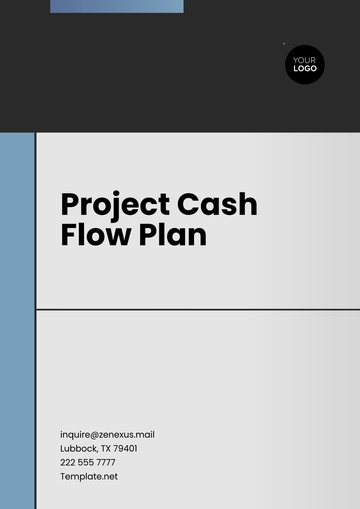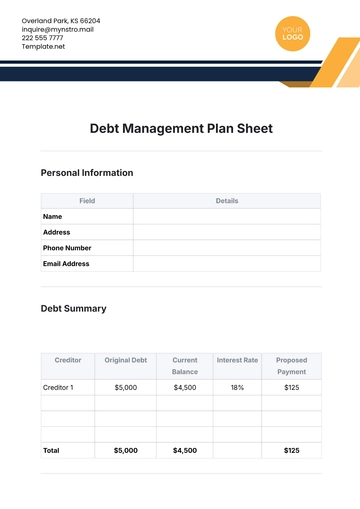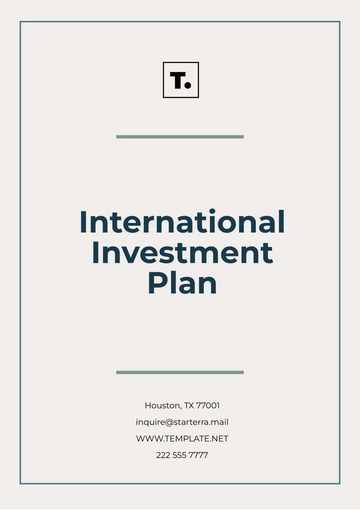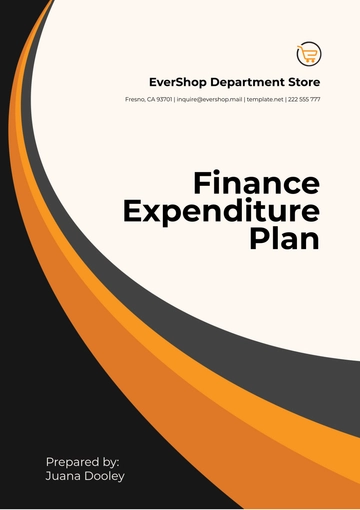Free Financial Instrument Plan
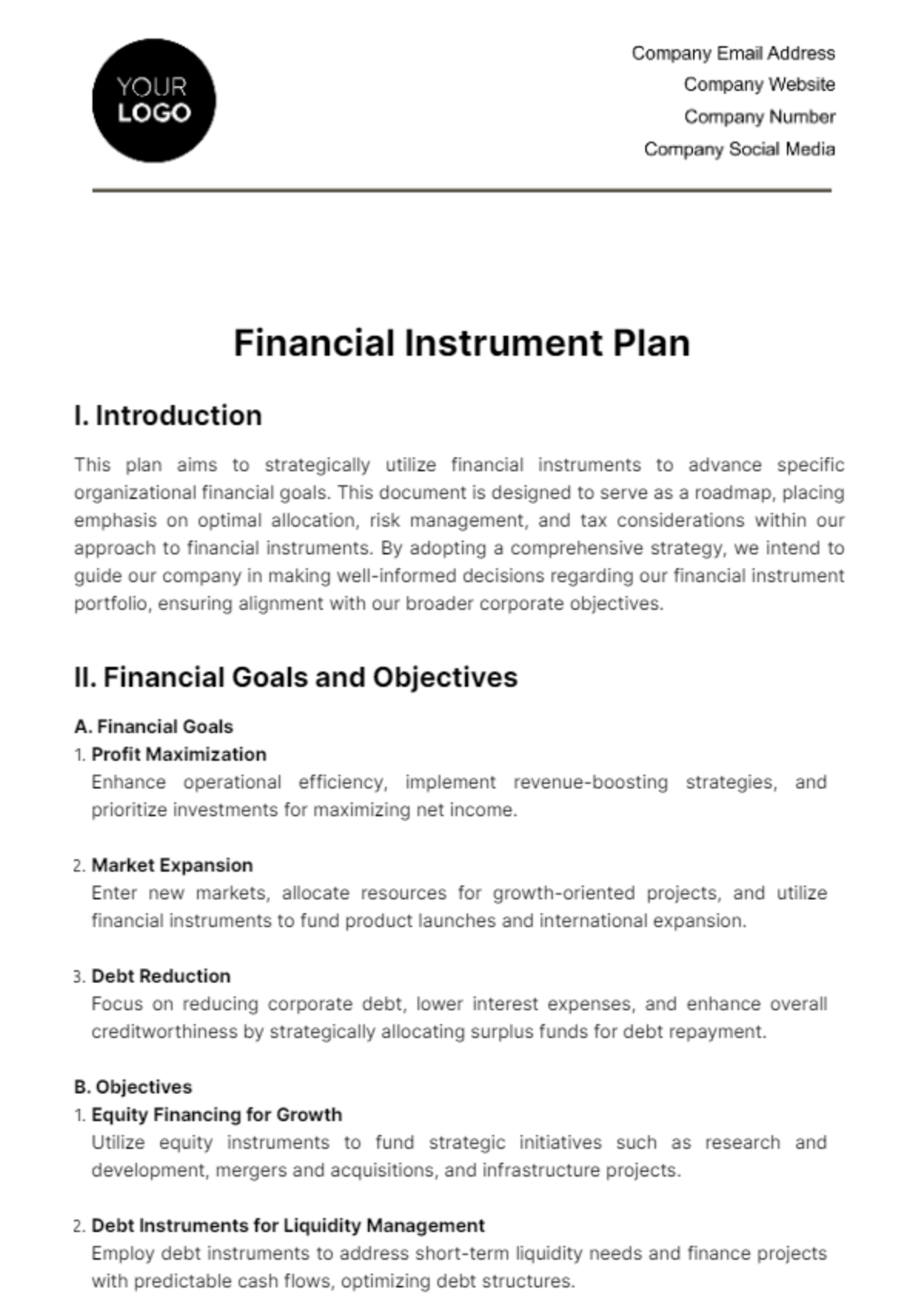
I. Introduction
This plan aims to strategically utilize financial instruments to advance specific organizational financial goals. This document is designed to serve as a roadmap, placing emphasis on optimal allocation, risk management, and tax considerations within our approach to financial instruments. By adopting a comprehensive strategy, we intend to guide our company in making well-informed decisions regarding our financial instrument portfolio, ensuring alignment with our broader corporate objectives.
II. Financial Goals and Objectives
A. Financial Goals
Profit Maximization
Enhance operational efficiency, implement revenue-boosting strategies, and prioritize investments for maximizing net income.
Market Expansion
Enter new markets, allocate resources for growth-oriented projects, and utilize financial instruments to fund product launches and international expansion.
Debt Reduction
Focus on reducing corporate debt, lower interest expenses, and enhance overall creditworthiness by strategically allocating surplus funds for debt repayment.
B. Objectives
Equity Financing for Growth
Utilize equity instruments to fund strategic initiatives such as research and development, mergers and acquisitions, and infrastructure projects.
Debt Instruments for Liquidity Management
Employ debt instruments to address short-term liquidity needs and finance projects with predictable cash flows, optimizing debt structures.
Diversification Strategy
Adopt a diversified portfolio approach, optimizing returns through balanced allocation of funds across various financial instruments and asset classes.
III. Corporate Risk Tolerance Assessment
A. Identification of Risk Tolerance Levels
Comprehensive Risk Analysis
Conduct an in-depth analysis of various risks associated with financial instruments, including market volatility, interest rate fluctuations, and credit risks.
Establish clear benchmarks and metrics to quantify the company's risk tolerance.
Quantitative and Qualitative Criteria
Utilize both quantitative and qualitative criteria to define risk tolerance, considering financial metrics, industry benchmarks, and the company's strategic objectives.
Incorporate feedback from key stakeholders to ensure a holistic understanding of risk appetite.
B. Risk Mitigation Strategies
Customized Risk Mitigation Plans
Develop customized risk mitigation plans for each financial instrument, aligning strategies with the identified risk tolerance levels.
Implement hedging strategies and diversification techniques to minimize exposure to specific risks.
Regular Risk Assessments
Conduct regular assessments of risk factors associated with financial instruments.
Adjust risk mitigation strategies dynamically based on evolving market conditions and the company's risk tolerance.
IV. Optimal Allocation of Financial Instruments
A. Diversification Strategy
Asset Class Diversification
Diversify the corporate portfolio across various asset classes, including equities, fixed income, and alternative investments.
Adjust allocations based on the risk-return profiles of different asset classes and market conditions.
Sector and Geographic Diversification
Implement sector and geographic diversification to mitigate concentration risk.
Evaluate opportunities for global investments while considering geopolitical and economic factors.
B. Strategic Asset Allocation
Long-Term Financial Strategy
Align asset allocation with the company's long-term financial strategy and goals.
Consider the investment horizon, liquidity needs, and evolving market dynamics in determining optimal allocation.
Dynamic Portfolio Adjustments
Implement a dynamic approach to portfolio adjustments, ensuring responsiveness to changing market conditions and financial goals.
Regularly review and rebalance the portfolio to maintain alignment with the company's evolving objectives.
V. Tax Planning Strategies
A. Tax-Efficient Investing
Strategic Investment Timing
Strategically time investments to optimize capital gains and losses for tax efficiency.
Leverage tax-efficient investment vehicles, such as index funds or tax-managed funds.
Utilization of Tax Credits
Identify and utilize available tax credits applicable to specific financial instruments or investment strategies.
Collaborate with tax professionals to maximize tax advantages within the legal framework.
B. Utilization of Tax-Advantaged Accounts
Maximization of Tax-Advantaged Contributions
Maximize contributions to tax-advantaged accounts, such as retirement funds or education savings accounts.
Leverage the tax deferral or exemption benefits provided by these accounts.
VI. Compliance and Regulatory Considerations
A. Regulatory Compliance Framework
Regulatory Review
Conduct a comprehensive review of relevant financial regulations impacting the use of specific financial instruments.
Establish a compliance framework that ensures adherence to regulatory requirements.
Legal Counsel Engagement
Engage legal counsel to provide ongoing guidance on compliance matters related to financial instruments.
Stay informed about updates in financial regulations and adapt the plan accordingly.
B. Risk Management Policies
Integration with Risk Management Framework
Integrate the financial instrument plan seamlessly with the overall risk management framework of the company.
Ensure that risk management policies align with regulatory requirements and industry best practices.
Regular Risk Audits
Conduct regular risk audits to assess the effectiveness of risk management policies and their alignment with regulatory guidelines.
Adjust risk management strategies based on audit findings and emerging regulatory changes.
VII. Documentation and Reporting
A. Documentation
Transaction Recordkeeping
Maintain thorough documentation of financial instrument transactions, including trade confirmations, contracts, and valuations.
The company will establish a centralized repository for easy retrieval and regulatory compliance.
Documentation of Compliance Procedures
Document compliance procedures related to the use of financial instruments, ensuring transparency and accountability.
Regularly update documentation to reflect changes in regulations or company policies.
B. Reporting Mechanisms
Performance Reports
Generate regular performance reports for the financial instrument portfolio, highlighting key metrics and benchmarks.
Distribute reports to relevant stakeholders for transparent communication.
Compliance Reports
Develop compliance reports detailing adherence to regulatory requirements.
Include summaries of risk management audits and actions taken to address any identified issues.
VIII. Monitoring and Adjustment of Financial Instruments
A. Regular Portfolio Reviews
Periodic Performance Evaluation
Conduct regular reviews of financial instrument performance against established benchmarks.
Evaluate the effectiveness of each instrument in contributing to overall financial goals.
Adaptive Decision-Making
Implement adaptive decision-making processes to respond to changes in market conditions, economic factors, and organizational objectives.
Adjust the financial instrument portfolio based on the outcomes of performance reviews and evolving financial landscapes.
B. Flexibility and Agility
Dynamic Rebalancing
Embrace dynamic rebalancing strategies to ensure that the financial instrument portfolio remains aligned with changing market dynamics and organizational needs.
Prioritize flexibility in adjusting allocations based on emerging opportunities or risks.
Continuous Alignment
Continuously align the financial instrument plan with the broader corporate strategy, ensuring that it remains responsive to organizational goals and external factors.
Foster a culture of adaptability to navigate uncertainties and capitalize on strategic opportunities.
- 100% Customizable, free editor
- Access 1 Million+ Templates, photo’s & graphics
- Download or share as a template
- Click and replace photos, graphics, text, backgrounds
- Resize, crop, AI write & more
- Access advanced editor
Plan financial instruments effectively with our Financial Instrument Plan Template from Template.net! This editable and customizable template streamlines financial instrument planning, ensuring clarity and precision. Level up your financial strategy with a tool designed for efficient planning and execution, all at your fingertips. Leverage the user-friendly AI Editor Tool immediately!
You may also like
- Finance Plan
- Construction Plan
- Sales Plan
- Development Plan
- Career Plan
- Budget Plan
- HR Plan
- Education Plan
- Transition Plan
- Work Plan
- Training Plan
- Communication Plan
- Operation Plan
- Health And Safety Plan
- Strategy Plan
- Professional Development Plan
- Advertising Plan
- Risk Management Plan
- Restaurant Plan
- School Plan
- Nursing Home Patient Care Plan
- Nursing Care Plan
- Plan Event
- Startup Plan
- Social Media Plan
- Staffing Plan
- Annual Plan
- Content Plan
- Payment Plan
- Implementation Plan
- Hotel Plan
- Workout Plan
- Accounting Plan
- Campaign Plan
- Essay Plan
- 30 60 90 Day Plan
- Research Plan
- Recruitment Plan
- 90 Day Plan
- Quarterly Plan
- Emergency Plan
- 5 Year Plan
- Gym Plan
- Personal Plan
- IT and Software Plan
- Treatment Plan
- Real Estate Plan
- Law Firm Plan
- Healthcare Plan
- Improvement Plan
- Media Plan
- 5 Year Business Plan
- Learning Plan
- Marketing Campaign Plan
- Travel Agency Plan
- Cleaning Services Plan
- Interior Design Plan
- Performance Plan
- PR Plan
- Birth Plan
- Life Plan
- SEO Plan
- Disaster Recovery Plan
- Continuity Plan
- Launch Plan
- Legal Plan
- Behavior Plan
- Performance Improvement Plan
- Salon Plan
- Security Plan
- Security Management Plan
- Employee Development Plan
- Quality Plan
- Service Improvement Plan
- Growth Plan
- Incident Response Plan
- Basketball Plan
- Emergency Action Plan
- Product Launch Plan
- Spa Plan
- Employee Training Plan
- Data Analysis Plan
- Employee Action Plan
- Territory Plan
- Audit Plan
- Classroom Plan
- Activity Plan
- Parenting Plan
- Care Plan
- Project Execution Plan
- Exercise Plan
- Internship Plan
- Software Development Plan
- Continuous Improvement Plan
- Leave Plan
- 90 Day Sales Plan
- Advertising Agency Plan
- Employee Transition Plan
- Smart Action Plan
- Workplace Safety Plan
- Behavior Change Plan
- Contingency Plan
- Continuity of Operations Plan
- Health Plan
- Quality Control Plan
- Self Plan
- Sports Development Plan
- Change Management Plan
- Ecommerce Plan
- Personal Financial Plan
- Process Improvement Plan
- 30-60-90 Day Sales Plan
- Crisis Management Plan
- Engagement Plan
- Execution Plan
- Pandemic Plan
- Quality Assurance Plan
- Service Continuity Plan
- Agile Project Plan
- Fundraising Plan
- Job Transition Plan
- Asset Maintenance Plan
- Maintenance Plan
- Software Test Plan
- Staff Training and Development Plan
- 3 Year Plan
- Brand Activation Plan
- Release Plan
- Resource Plan
- Risk Mitigation Plan
- Teacher Plan
- 30 60 90 Day Plan for New Manager
- Food Safety Plan
- Food Truck Plan
- Hiring Plan
- Quality Management Plan
- Wellness Plan
- Behavior Intervention Plan
- Bonus Plan
- Investment Plan
- Maternity Leave Plan
- Pandemic Response Plan
- Succession Planning
- Coaching Plan
- Configuration Management Plan
- Remote Work Plan
- Self Care Plan
- Teaching Plan
- 100-Day Plan
- HACCP Plan
- Student Plan
- Sustainability Plan
- 30 60 90 Day Plan for Interview
- Access Plan
- Site Specific Safety Plan



